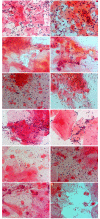Comparison between Gram stain and culture for the characterization of vaginal microflora: definition of a distinct grade that resembles grade I microflora and revised categorization of grade I microflora
- PMID: 16225680
- PMCID: PMC1266370
- DOI: 10.1186/1471-2180-5-61
Comparison between Gram stain and culture for the characterization of vaginal microflora: definition of a distinct grade that resembles grade I microflora and revised categorization of grade I microflora
Abstract
Background: The microbiological diagnosis of bacterial vaginosis is usually made using Nugent's criteria, a useful but rather laborious scoring system based on counting bacterial cell types on Gram stained slides of vaginal smears. Ison and Hay have simplified the score system to three categories and added a fourth category for microflora with a predominance of the Streptococcus cell type. Because in the Nugent system several cell types are not taken into account for a final score, we carried out a detailed assessment of the composition of the vaginal microflora in relation to standard Gram stain in order the improve the diagnostic value of the Gram stain. To this purpose we compared Gram stain based categorization of vaginal smears with i) species specific PCR for the detection of Gardnerella vaginalis and Atopobium vaginae and with ii) tDNA-PCR for the identification of most cultivable species.
Results: A total of 515 samples were obtained from 197 pregnant women, of which 403 (78.3%) were categorized as grade I microflora, 46 (8.9%) as grade II, 22 (4.3%) as grade III and 8 (1.6%) as grade IV, according to the criteria of Ison and Hay. Another 36 samples (7.0%) were assigned to the new category 'grade I-like', because of the presence of diphtheroid bacilli cell types. We found that 52.7% of the grade I-like samples contained Bifidobacterium spp. while L. crispatus was present in only 2.8% of the samples and G. vaginalis and A. vaginae were virtually absent; in addition, the species diversity of this category was similar to that of grade II specimens.Based on the presence of different Lactobacillus cell types, grade I specimens were further characterized as grade Ia (40.2%), grade Iab (14.9%) and grade Ib (44.9%). We found that this classification was supported by the finding that L. crispatus was cultured from respectively 87.0% and 76.7% of grade Ia and Iab specimens while this species was present in only 13.3% of grade Ib specimens, a category in which L. gasseri and L. iners were predominant.
Conclusion: Further refinement of Gram stain based grading of vaginal smears is possible by distinguishing additional classes within grade I smears (Ia, Iab and Ib) and by adding a separate category, designated grade I-like. A strong correlation was found between grade Ia and the presence of L. crispatus and between grade I-like and the presence of bifidobacteria. This refinement of Gram stain based scoring of vaginal smears may be helpful to improve the interpretation of the clinical data in future studies, such as the understanding of response to treatment and recurrence of bacterial vaginosis in some women, and the relationship between bacterial vaginosis and preterm birth.
Figures

References
-
- Forsum U, Jakobsson T, Larsson PG, Schmidt H, Beverly A, Bjornerem A, Carlsson B, Csango P, Donders G, Hay P, Ison C, Keane F, McDonald H, Moi H, Platz-Christensen JJ, Schwebke J. An international study of the interobserver variation between interpretations of vaginal smear criteria of bacterial vaginosis. APMIS. 2002;110:811–8. doi: 10.1034/j.1600-0463.2002.1101107.x. - DOI - PubMed
-
- Thomason JL, Anderson RJ, Gelbart SM, Osypowski PJ, Scaglione NJ, el Tabbakh G, James JA. Simplified gram stain interpretive method for diagnosis of bacterial vaginosis. Am J Obstet Gynecol. 1992;167:16–9. - PubMed
-
- Hay PE, Taylor-Robinson D, Lamont RF. Diagnosis of bacterial vaginosis in a gynaecology clinic. Br J Obstet Gynaecol. 1992;99:63–6. - PubMed
Publication types
MeSH terms
LinkOut - more resources
Full Text Sources
Other Literature Sources
Miscellaneous

